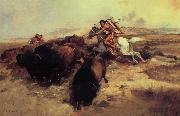Wholesale Oil Painting No Minimum |
|||||||||||
|
|
|||||||||||

|
|||||||||||
|
|
|
||||||||
Charles M RussellAmerican Painter, 1864-1926 American painter and sculptor. In 1880 he left his upper-class home in St Louis for Montana Territory. He worked briefly on a sheep ranch, spent two years as a hunter's and trapper's assistant and then became a cowboy. During his considerable spare daytime hours he painted, sketched and modelled small animal figures in clay (e.g. Antelope, 1915; Fort Worth, TX, Amon Carter Mus.). Although he painted a few exceptional oils and watercolours prior to 1900, the vast majority of his best work was done in the last two decades of his life. Typically the subject-matter centres around cowboy life (e.g. Wagon Boss, 1909; Tulsa, OK, Gilcrease Inst. Amer. Hist. & A.) and the Plains Indians, for whom he had great respect. The luminous Piegans (1918; Denver, CO, Mus. W. A.), with its depiction of the Plains Indians, is a reminder of the vastness of the American West. Russell's sense of humour and empathy for his subject-matter radiates from his paintings as pleasingly as do the clear colours of the high country. His bronze sculptures (e.g. Buffalo Hunt, 1905; Denver, CO, Mus. W. A.) depict the same dramatic and tension-packed themes as his paintings. |
||||||||
|
|
||||||||
Buffalo Hunt
Buffalo Hunt Painting ID:: 45965 |
mk178
1897
oils on linen mk178 1897 oils on linen |
|||||||
|
|
||||||||
|
Alfred Jacob Miller American Painter, 1810-1874 1810?C74, American artist, b. Baltimore, studied under Thomas Sully and in Europe. In 1837 he joined an expedition to the American West and was probably the first artist to depict the Rocky Mts. On that trip he produced his most important works, chiefly studies of Native American and frontier life, valuable for their documentary detail. These sketches and watercolors were entirely forgotten for nearly a century until they were rediscovered in a storeroom of the Peale Museum, Baltimore. Buffalo Hunt mk217 |
||||||||
|
|
||||||||
|
Prev Next
|
||||||||
|
|
||||||||
|
Related Paintings to Alfred Jacob Miller :. |
||||||||
|
|
||||||||
|
CONTACT US |

